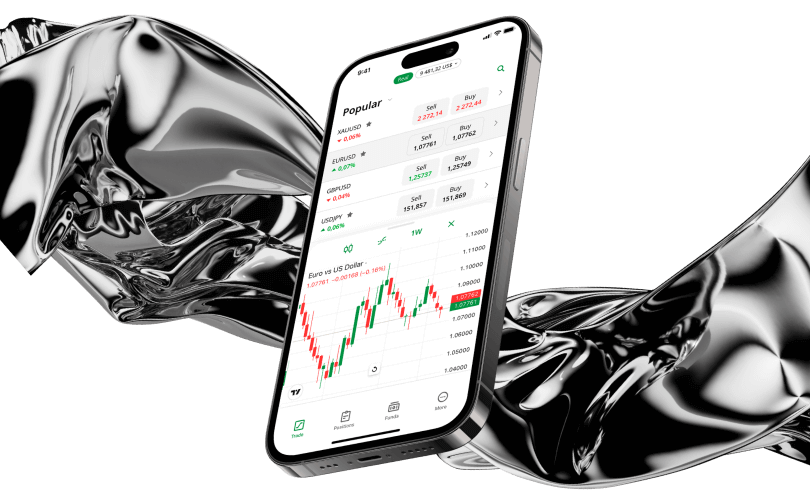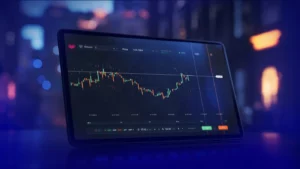Mobile trading has become the standard for many active traders who prefer flexibility without sacrificing performance. Reliable mobile applications now deliver fast execution, technical analysis tools, and real-time data once limited to desktop terminals. For both forex and crypto traders, selecting the right app can make a measurable difference in decision-making and risk control.
What to Look for in a Mobile Trading Platform
Choosing the right trading app involves more than checking ratings on app stores. Functionality, data accuracy, and execution quality matter more than cosmetic appeal. Below are the main elements that define a dependable trading environment on mobile.
User Interface and Charting Tools
The interface should allow quick access to open trades, indicators, and timeframes without unnecessary menus.
Professional traders prefer clean layouts that display real-time bid/ask quotes and multiple chart types such as candlesticks, Heikin-Ashi, and Renko.
Modern apps now include:
- Multi-chart view for monitoring several pairs simultaneously
- Pinch-to-zoom and drag navigation
- Built-in indicators like RSI, MACD, Bollinger Bands
- Custom indicator import (available on advanced apps like MT5 or cTrader)
- Order-entry panel directly from the chart
A concise interface minimizes execution delays — an essential factor in volatile markets.

Execution Speed and Stability
Price movement on forex and crypto pairs can shift by several pips or ticks within seconds.
For that reason, order execution and server connectivity determine whether a trader receives the intended entry price. Reliable apps typically connect to multiple data centers, reducing latency and quote freezes.
Key technical aspects to evaluate:
| Parameter | Ideal Range | Why It Matters |
| Average Execution Time | <100 ms | Prevents slippage during fast market moves |
| Server Downtime | <0.5% annually | Ensures continuous access during high volatility |
| Order Rejection Rate | <1% | Indicates system stability and liquidity quality |
Traders often run speed tests or compare execution records between demo and live servers before committing real funds.
Security Features and Account Protection
Financial data security must be treated as seriously as trading performance. The best mobile terminals apply multi-layer protection combining encryption, biometric login, and withdrawal confirmation protocols.
Look for apps that include:
- Two-factor authentication (2FA) for login and withdrawals
- Data encryption (AES-256) between server and client
- Session timeout settings for unattended devices
- Withdrawal whitelists to prevent transfers to unapproved addresses
- Automatic logout when switching networks
Security design should not obstruct workflow but must stop unauthorized access. Some traders also use VPNs or hardware tokens to add another layer of control when operating on public networks.
Top Mobile Trading Platforms for Forex
The forex sector has several mobile terminals competing for dominance, each with distinct execution engines and charting logic. Below are the most used solutions among both institutional and retail traders.
MetaTrader 4 (MT4) Mobile App Overview
MT4 remains one of the most recognized mobile trading solutions. Its interface focuses on simplicity and reliability. Despite being developed in the early 2000s, it continues to dominate due to its lightweight architecture and stable execution.
MT4 key aspects:
| Feature | Description |
| Supported Markets | Forex, CFDs, metals |
| Indicators | 30 built-in, plus custom MQL4 scripts |
| Orders | Market, limit, stop, trailing stop |
| Timeframes | 9 intervals from 1 minute to 1 month |
| Compatibility | iOS, Android |
The mobile version syncs with the desktop terminal, allowing position monitoring, instant execution, and chart annotation. Although it lacks depth-of-market visualization, it remains reliable for intraday operations.
MetaTrader 5 (MT5) Mobile App Overview
MT5 expanded on MT4 by introducing more order types, depth-of-market display, and extended analytical tools. The mobile app replicates much of the desktop terminal’s core functionality while improving performance.
Advantages over MT4:
- 21 timeframes and 80+ analytical tools
- Economic calendar integration
- Support for exchange-traded instruments and stocks
- Multi-threaded strategy testing
Quick comparison table:
| Feature | MT4 | MT5 |
| Order Types | 4 | 6 |
| Economic Calendar | No | Yes |
| Market Depth | No | Yes |
| Instruments | Forex/CFDs | Forex/CFDs/Stocks/Futures |
| Scripting Language | MQL4 | MQL5 |
Traders focusing on multi-asset portfolios usually prefer MT5 because of its extended order management features and real-time news integration.
cTrader Mobile and Its Key Features
cTrader is known for its institutional-grade interface and precise execution model. It’s widely adopted by brokers offering ECN connectivity. The app integrates market depth data, one-tap trading, and detailed trade analytics.
Distinct elements include:
- Full Level-II pricing (up to 10 liquidity providers)
- Advanced order protection such as “Close by” and “Reverse”
- Integrated trade analytics with entry/exit visualization
- Algorithmic trading synchronization via cAlgo (for desktop)
Its clean design and quick order routing make it favored by scalpers and algorithmic traders.

TradingView Mobile – Analysis on the Go
TradingView focuses primarily on technical analysis and community insights. The mobile app syncs with cloud-saved layouts, allowing instant access to previously configured charts.
While it doesn’t execute trades directly for all brokers, it connects through supported integrations such as OANDA, and Binance.
Popular features:
- Over 100 preloaded indicators and drawing tools
- Multi-chart layouts and price alerts
- Real-time synchronization across devices
- Social sentiment analysis and public idea sharing
Traders often use TradingView mobile for analysis and pair it with execution terminals like MT5 or cTrader for order management.
Top Mobile Trading Platforms for Crypto
The demand for mobile apps in crypto trading has expanded rapidly as traders seek full control of positions from their phones. The best crypto platforms combine speed, liquidity, and reliable API connections to major exchanges. While many solutions share features with forex apps, crypto-specific versions often include wallet management and direct blockchain integrations.
Leading mobile apps for crypto trading:
| Platform | Supported Assets | Key Tools | Ideal For |
| Binance App | 350+ coins | Spot, Futures, Options, Grid bots | Active short-term traders |
| Bybit App | 200+ pairs | Perpetual contracts, Copy trading | Derivatives specialists |
| Coinbase Advanced | 100+ coins | Depth chart, limit/stop orders | Beginners trading spot markets |
| OKX App | 300+ pairs | Cross-margin, DEX access, earn products | Advanced multi-strategy traders |
Each app offers unique configurations. Binance and Bybit emphasize order execution and depth-of-market precision, while Coinbase simplifies the interface for less experienced users.
Security remains essential — most apps now implement biometric verification, withdrawal whitelists, and cold-storage asset segregation.
Another aspect unique to crypto mobile trading is wallet integration. Some apps, like OKX, allow internal transfers between spot, futures, and staking balances without leaving the interface. This reduces latency between positions and simplifies portfolio management.
Comparing Forex and Crypto Mobile Platforms
Both forex and crypto apps provide fast access to financial markets, but their internal architecture and risk parameters differ. Understanding these differences helps traders choose the correct setup depending on the instrument type.
Differences in Interface and Order Types
Forex apps such as MT4 and MT5 focus on precision and order management within regulated liquidity pools.
Crypto apps, by contrast, often use order book matching directly on exchange servers, which can result in faster but less predictable fills during volatility.
Comparison table:
| Element | Forex Platforms | Crypto Platforms |
| Order Routing | Broker/dealer network | Direct exchange matching |
| Typical Spread | 0.1–1.5 pips (major pairs) | Variable (based on liquidity) |
| Order Types | Market, limit, stop, trailing | Market, limit, stop, OCO, trigger |
| Regulation | FCA, CySEC, ASIC, FSCA | Exchange-based or unregulated |
| Leverage Range | 1:30 to 1:2000 | 1:1 to 1:125 |
Forex systems prioritize price stability and compliance, while crypto systems focus on speed and flexibility.
This distinction becomes visible when testing order placement — forex apps rarely freeze, but crypto apps may slow down during network congestion.
Volatility and Liquidity Considerations
Volatility levels vary greatly between these two asset classes. Forex pairs such as EUR/USD or USD/JPY generally move within a few percentage points daily. Crypto assets like BTC or ETH can fluctuate by 5–15% within hours. This affects position sizing, stop-loss placement, and margin requirements.
Typical average volatility comparison:
| Asset | Daily Range (Average) | Typical Margin Requirement |
| EUR/USD | 0.6% | 1–2% |
| GBP/JPY | 1.1% | 2–3% |
| BTC/USDT | 4.5% | 10–20% |
| ETH/USDT | 3.8% | 8–15% |
For this reason, many traders prefer keeping both forex and crypto apps installed. They trade currency pairs for stability and digital assets for high momentum opportunities.
Crypto liquidity depends on exchange volume and network load, while forex liquidity is supplied by interbank networks.
Tips for Trading Safely on Mobile
Security and operational discipline are essential when managing positions through mobile devices. A few practical measures reduce exposure to technical or human errors.
- Use authorized broker or exchange apps only. Always download from official websites or verified app stores. Avoid APK installations or third-party marketplaces that might contain modified files.
- Avoid public Wi-Fi connections. Unsecured networks can expose login credentials. Use mobile data or a trusted VPN for safer access.
- Enable biometric login and 2FA. Face or fingerprint recognition combined with two-factor codes significantly decreases unauthorized entry risks.
- Keep system software updated. Outdated operating systems may have security vulnerabilities. Regular updates patch known exploits.
- Separate trading devices from personal use. Running social or entertainment apps alongside trading software increases the chance of malware infections. Professional traders often dedicate one device exclusively to trading.
- Test before scaling capital. Always verify performance on demo or low-balance accounts before transferring large amounts. This helps assess execution delays and data accuracy under live market conditions.
These precautions not only protect funds but also reduce operational disruptions that often occur during volatile periods.
Tools That Improve Mobile Trading Efficiency
Advanced traders rely on a combination of built-in and external tools to maintain precision on smaller screens. Efficiency depends on automation, alert systems, and cross-device synchronization.
Practical tools to consider:
- Economic calendars integrated into MT5 or external sources for real-time news updates.
- Price alert apps for instant push notifications on target levels.
- Trade journal apps for tracking performance metrics.
- VPNs for consistent server routing and reduced latency.
- Cloud-based data backup for chart layouts and settings.
Automation has also become more accessible. Certain brokers now link Expert Advisors (EAs) or API trading bots to their mobile dashboards, allowing remote strategy monitoring without full desktop control.
Frequently Asked Questions
Which mobile trading app suits both forex and crypto markets?
MT5 and TradingView are strong cross-market options. MT5 offers multi-asset access, while TradingView connects with several brokers and exchanges for analysis and order placement.


